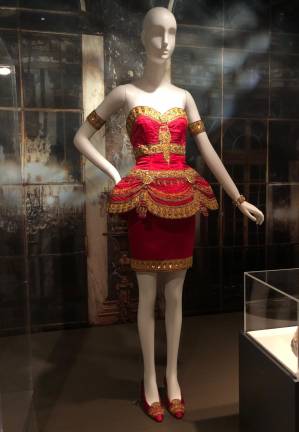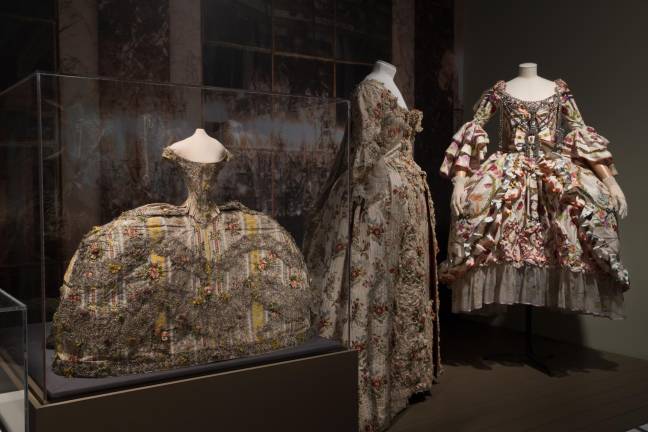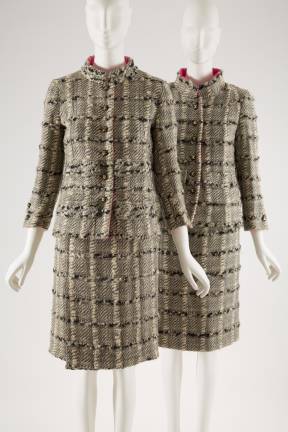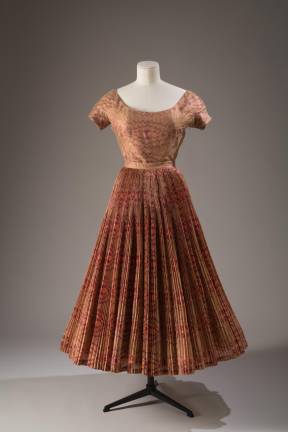There may be fashion weeks spanning the globe today, in Lagos, Moscow, São Paulo and Shanghai, but Paris remains the leader of the pack – the world capital of chic, despite the heat. This is the conclusion of The Museum at FIT’s director and chief curator, Valerie Steele, whose lifelong obsession with the City of Light has culminated in the new exhibit, “Paris, Capital of Fashion,” a fresh take on why the French still rule the fashion world.
“It’s not just that geniuses sprang up like mushrooms after a rain along the Seine, but the idea of Paris as the capital of fashion was something that was constructed over centuries in the face of waves of competition,” Steele argued at a preview. “Ironically, globalization has also reinforced the power of the Big Four—Paris, New York, Milan and London, and, in particular, it has reinforced the power of Paris. Because the idea that Paris is the most glamorous, competitive capital has attracted the cream of designers.”
Nearly Four Hundred Years of Style
Paris has branded itself “Fashion City,” with support from the French government that dates back to the 17th and 18th centuries and continues today. Louis XIV’s minister of finance, Jean-Baptiste Colbert, famously (fictitiously?) observed: “Fashion is to France what the gold mines of Peru are to Spain.” By the 1670s, luxury apparel and other high-end commodities had become a “source of wealth and ‘soft power’ for the French state,” according to the show’s brochure, with Paris an established center of new fashion.
The city and the court of Versailles – a “two-headed fashion capital” – worked hand in hand to raise the profile of the French. The show’s main gallery boasts a mini re-creation, in photos, of the Hall of Mirrors at the royal chateau and pairs period outfits with the styles they spawned.
“There developed over time a direct transition from the splendor of the royal court to the spectacle of the haute couture,” Steele said, pointing to “that wonderful corset and court panniers [side hoops],” on view. “This shows the structure and formality and craftsmanship that went into Old Régime fashion, and which continues to have echoes through the imagery and ethos of high fashion in Paris subsequently.”
A Versailles Party
“Enchanted Island” is a red-and-gold dress by Karl Lagerfeld for Chanel (1987-88, fall/winter), specifically inspired by a party at Versailles thrown by Louis XIV. Said the curator: “There is a sense, reinforced over and over in couture, particularly in the 20th and 21st centuries, that you are looking back at Versailles as a template for high, artistic, aristocratic fashion – which is separate from mass, industrialized fashion, which, in the French view, is what the rest of the world produces.”
Don’t miss the painted fan of Versailles, dated 1680-90, and another historical gem: a fashion doll from the 1760s, in court-style dress, with huge panniers, on loan from The Fashion Museum in Bath. Before magazines, these poupées de mode were dressed in the latest styles and “literally sent everywhere, from Constantinople to Virginia” to promote the goods.
“At that point...for foreigners, a dress had to be made in Paris to be considered fashionable,” Steele said of the city’s mystique.
The Father of Haute Couture
Enter English-born designer Charles Frederick Worth, who established a couture house in Paris in 1858 and disrupted the fashion system. Known as the father of haute couture (“high sewing”), Worth transformed dressmaking from small-scale craft into big business. He employed hundreds of workers and told women what they should be wearing.
“’I’m the artist, you choose from what I am giving you,’” Steele characterized his approach. Labels with his signature were sewn into garments, as if they were artworks. His innovations and the rise of haute couture, which glorified individual designers, cemented Paris’ status as the glamor capital.
Worth catered to royalty and the queens of New York society. For Mrs. Cornelius Vanderbilt, he designed the “Electric Light” dress (1883), on display, which originally included a torch that could be illuminated with a battery pack.
Paris Across Cultures
In the early 19th century, Paris increasingly became associated with women’s fashion, ceding dominance in menswear to London’s Savile Row. New York would later top ready-to-wear, copying haute designs and selling them for less at department stores – just one example of “the way the idea of Paris works across cultures,” Steele said in the front room, which looks at the city in a global context.
“For instance, we have a Chanel suit, and that is purchased by Orbach’s in the 1960s and they make a copy,” she said next to a display that juxtaposes the real thing with an imitation. “And so instead of it being $400, which was what a couture suit was then, it was like $30.”
But all roads lead to Paris, according to the narrative, despite interruptions like the Nazi occupation of the capital during the Second World War and competition from abroad. The cachet is inescapable, the mythology too alluring to resist. It’s where talented designers of all stripes – all races and nationalities – want to be, and where the Big Five luxury fashion houses (Christian Dior, Chanel, Lanvin, Hermès and Louis Vuitton) are headquartered. The foundation for success was carefully laid centuries ago, a key to the city’s continued preeminence.
IF YOU GO
What: “Paris, Capital of Fashion”
Where: The Museum at FIT, Seventh Avenue at 27th Street fitnyc.edu/paris
When: Through January 4, 2020



